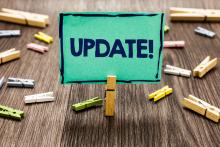Lead-Safe Wisconsin: Regulatory Updates for Lead Investigators
The Lead and Asbestos Program compiled this set of updates and a risk assessment reminder to provide a single reference location for these important communications.
2025 Updates
The Environmental Protection Agency (EPA) published a rule change to dust lead standards in pre-1978 dwellings and child-occupied facilities. Read the EPA fact sheet describing the final rule (PDF) and presentation slide from the EPA webinar for more information.
What changed
The final rule introduces new standards and terminology for lead-dust standards in risk assessments and clearances.
- Dust-lead reportable levels (previously known as dust-lead hazard standards) changed to any reportable level.
- Dust-lead action levels (previously known as dust-lead clearance levels) changed from:
- 10 micrograms per square foot (µg/ft2) to 5 µg/ft2 for floors
- 100 µg/ft2 to 40 µg/ft2 for windowsills
- 400 µg/ft2 to 100 µg/ft2 for window troughs
Wisconsin has an EPA-authorized lead program. The Wisconsin Department of Health Services (DHS) must revise Wis. Admin. Code ch. DHS 163 to align with EPA’s changes by January 11, 2027.
What this means for you
Continue to follow Wis. Admin. Code ch. DHS 163 when doing regulated lead work in Wisconsin.
DHS will start the process to revise Wis. Admin. Code ch. DHS 163. This may take up to two years.
For information about administrative rules, visit The Wisconsin State Legislature website.
How you can get involved
DHS will form a technical advisory committee for consultation on revisions. If you are interested in serving on this committee, apply by March 1, 2025. Other opportunities for public input will also be available.
2024 Updates
Wisconsin Admin. Code ch. DHS 163 requires all certified lead investigators to report all lead investigations they’ve conducted to DHS on a quarterly basis.
In the past, the Department of Health Services (DHS) sent email reminders from an employee’s work email address to submit your summary as soon as each quarter ended. Now, these courtesy reminder emails are being sent as GovDelivery (GovD) emails and are coming from the Wisconsin Department of Health Services.
Do not reply to the GovD email as it does not go to an email box that is monitored. Be sure to follow the instructions provided in the email as to how to quarterly report.
We now hold quarterly Q&A sessions about lead investigations. We will answer your questions and share tips about this work.
All certified lead investigators will receive an email inviting them to join the session approximately two weeks prior to the session.
To make sure you receive the invitation, verify that your email address on file is current.
Unable to attend the live Q&A session? View past sessions
We recommend having separate scopes of work for interior and exterior lead work when possible. This will allow clearance to be conducted separately for interior or exterior.
Having separate scopes of work for the interior and exterior will allow for clearance examiners to easily determine that all work has been completed and allow for the residents to return to the dwelling after the interior has passed clearance and exterior work remains.
It is important to note that additional interior clearances may be required if work "breaking the envelope of the house" is not conducted with the first stage of work.
What should I do if I am attempting a clearance examination and realize the work was not completed as determined by the scope of work?
Since the work was not completed to the scope of work, stop the clearance examination as it failed the visual inspection. Do not collect dust wipe samples. Determine if there were changes to work orders that were not provided to you.
If the work was not completed to the scope of work and the residents need to be back in the dwelling before the work can be completed (for example, long material delays or changes in abatement contractor doing the work), you can seek an Approved Alternative to an Administrative Requirement (Wis. Admin. Code ch. 163.02(2)) prior to conducting a clearance for habitation before the completion of the project.
While DHS has 20 days to process the request, we do understand the urgency to get a family back in their home and would try to approve an alternative that is as protective as the rule as soon as possible. This can be submitted by the risk assessor or the client by an email to DHSAsbestosLead@dhs.wisconsin.gov.
Requests for approval of an alternative to a requirement must be in writing and explain:
- The part of the rule you are seeking an alternative to.
- The reason for the request.
- The steps that will be taken to protect human health (the alternative must be as protective as the part of the rule).
- That clearance will be conducted, and must pass, after both stages of the project for the residents to return after each stage.
When snow prohibits the visual inspection of the exterior clearance, it is acceptable to postpone this step without prior approval from the Department of Health Services (DHS). You must:
- Verify all work is complete.
- Inspect areas not covered by snow (for example, clearance of interior work) to verify that no dust, debris, or residue is present.
- Note in your clearance report that you did not complete the visual inspection of the exterior due to snow cover.
- Return to conduct the exterior clearance as soon as the ground is free of snow.
See BEOH Memo 2024-02: Conducting Clearance in Stages Due to Snow Cover (PDF) for more information.
For information on how to amend a risk assessment report, visit Lead-Safe Wisconsin: Amending a Risk Assessment Report.

